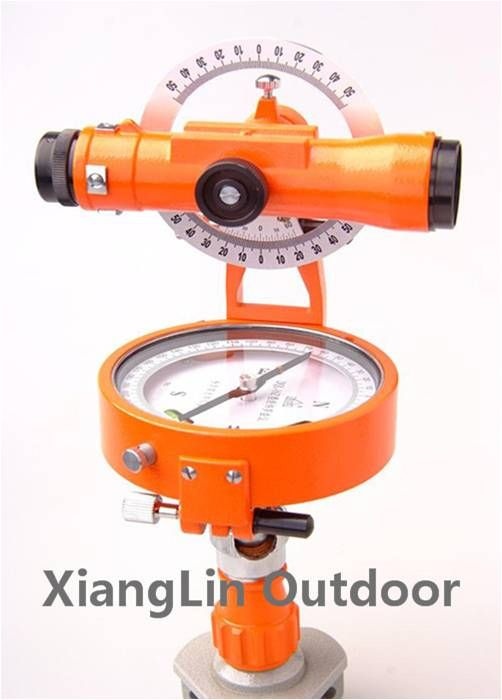Measurement of Vertical Angles: Usually a Vertical Angle is an angle which is subtended between the inclined LOS and the horizontal LOS, in the vertical plane. If the point sighted is situated above the horizontal axis of the Theod, it is called the Angle of Elevation and vice-versa for Angle of Depression.
Steps for measuring a Vertical Angle: (i) Set up the Theod and level it very accurately in all the levelling bubbles.
(ii) Set the zero of the vertical vernier exactly coinciding with the zero of the vertical scale (small side vernier scale). Check whether all the bubbles are still in centre (otherwise centre them). If they are in centre, then the line of collimation of the telescope is perfectly horizontal and both the verniers will read zero.
(iii) Loosen the vertical clamp screw, swing the telescope in vertical plane and bisect an object. Use the vertical tangent screw for accurate bisection.
(iv) Read both the verniers of vertical circle. The mean of the two vernier readings will give the vertical angle. Then the observations should be made with changed face i.e. opposite face. Average of the first one value with a certain face and second one value with opposite face will give the required true vertical angle.
Operations with Theodolite:
(i) Measurement of Bearing: Bearing of a line is measured with a Theod provided / fitted with a compass.
Steps for measuring the Bearing of a line: (i) Set up the Theod at a certain station (say) A and level it accurately so that the vernier should read zero.
(ii) Loosen the lower clamp and release the needle of compass. Rotate the compass till the needle roughly point to North. Tighten the lower clamp.
(iv) Loosen the upper clamp and point the telescope towards the other station (say) B. Bisect B accurately using the upper
(v) Change the face and repeat the steps (ii) to (iv). Average of the two readings with the two faces will give the correct bearing of the line AB.

Operations with Theodolite:
(ii) Measurement of Direct Angles: Direct Angles are the angles which are measured clockwise from the previous line to the next line. They are also called Angles to the Right or Azimuths , vary from 0o to 360o and are measured usually using a Theod.
Steps for measuring the Direct Angles: (i) Set up the Theod at B and level it accurately. With Face Left, set the vernier to read zero.
(ii) Loosen the lower clamp and sight A. Bisect A accurately using the lower tangent screw.
(iii) Loosen the upper clamp and swing the telescope clockwise to sight C. Bisect C accurately using .
(iv) Plunge the telescope and loosen the lower clamp; read the back-sight reading for A. The reading on the vernier will be same as that obtained in the step (iii).
(v) Again loosen the upper clamp to bisect C; read the verniers. The reading will be equal to twice the angle ABC. Correct value of angle ABC will be obtained by dividing the final reading by two.
Similarly, measure the other angles by using this method.
(iii) Measurement of Deflection Angle (): Deflection Angle is an angle by which the survey line at some point deflects (bends or turns aside) to the other direction.
Steps for measuring the Deflection Angle: (i) Set up the Theod at B and level it accurately. Clamp both the plates at 0o; take back-sight at A.
(ii) Plunge the telescope. LOS is now in the direction of line AB produced. When the vernier is read, it will be zero at A.
(iii) Loosen the upper clamp and swing the telescope clockwise to take fore-sight at C. Read both the verniers.
(iv) Unclamp the lower plate and sight A again. The vernier will still read the same reading as in A. Now plunge the telescope.
(v) Again loosen the upper clamp, turn the telescope and sight C again; read both the verniers. Half of the final reading will give the deflection angle at B.
Similarly, other two deflection angles β and γ can also be measured in the same way.
Operations with Theodolite:
(iv) Establishing a line beyond an obstruction e.g. building: (i) Set up the Theod at B (situated beside one corner of a building) and sight on the ranging rod held at A (a point situated towards the observer but away from that building). Clamp the lower plate; bisect A accurately using the lower tangent screw.
(ii) Release the upper plate and turn the telescope by 90o and establish a point C (on the observer’s side) clear to the building’s LOS being obstructed by that building.
(iii) Carry the instrument to point C and set a line CD (with Theod and Ranging Rod) at right angle to the line BC.
(iv) Again carry the instrument to point D and set a line DE (with Theod and Ranging Rod) at right angle to the line CD.
(v) Measure (by tape or chain) the length of line DE equal to the length of line BC and confirm its right angle from the line CD by holding and bisecting the Ranging Rod at a newly established point E.
(vi) Again carry the instrument to point E and set a line EF (with Theod and Ranging Rod) at right angle to the line DE. Now the line EF will be the extension of the first line AB extended beyond the
(v) Lining-in on a given line: It is a method of establishing the intermediate point or points on a given line, provided the end points are visible from each end point. (i) Set up the Theod at A. Centre and level it accurately. Clamp the upper plate.
(ii) Turn the telescope until the point B is bisected. Clamp the lower plate and bisect B accurately using the lower slow motion screw.
(iii) Now ask the staff-man to hold the Ranging Rod approx at point C in the line of AB.
(iv) Look through the telescope to coincide the LOS of B with the LOS of AB.
(v) Repeat the above step with opposite face of telescope (e.g. Face Right) to check any discrepancy which should be corrected by choosing a mean position for the point C, until the point C will be in line of LOS of AB.
(vi) Wiggling-in or Buckling-in (also known as Balancing-in or Inter-lining) on a given line:
It is a method of establishing the intermediate point or points on a given line, provided the end points are NOT visible from each end point but the end points are visible from the intermediate points, as in case of a hill coming in the way of the main surveying line running along the ground.
(i) Set up the Theod at an intermediate point (say) C1 situated in the estimated way of but as close as possible to the line AB.
(ii) Take back-sight to the point A. Plunge the telescope and sight the point B. Now the LOS will, of course, not be in the line of B, but in the line of a nearly situated pointed (say) B1.
(iii) Measure the distance BB1 and position of the instrument between A and B e.g. half-way, one-third or one-quarter of the distance AB.
(iv) An estimate is made that how far the instrument is to be moved from the point C1 to be in the line of line AB, according to the proportion calculated from the position of point C1 and the (measured) distance BB1.
(v) Now the instrument is again roughly set on a different point C2 that will be closer to the line AB than the position of point C1.
) Repeat the above-sighting procedure until after having sighted the point A, the transited LOS strikes the point B.
(vii) This newly established point which will be in the accurate line of the line AB is (say) C.
N.B: The instrument is roughly set up on the out-of-line points C1 and C2. but accurately set up the final point C which is in the line of the line AB.
(vii) Prolonging a Straight Line:
(i) Set up the instrument at point A; centre and level it accurately.
(ii) Bisect a ranging rod held at the point B.
(iii) Establish a point C away from point B but in the straight line of line AB.
(iv) Shift the instrument at the point B; centre and level it accurately.
(v) Bisect the ranging rod held at a new point D.
(vi) Establish the point D away from point C but in the straight line of line AC.



